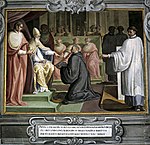| Revision as of 16:03, 15 May 2011 editLuckas-bot (talk | contribs)929,662 editsm r2.7.1) (robot Adding: eu:Eztebe II.a← Previous edit | Revision as of 08:22, 25 June 2011 edit undoEmausBot (talk | contribs)Bots, Template editors2,857,001 editsm r2.6.4) (robot Modifying: ca:Papa Esteve IINext edit → | ||
| Line 77: | Line 77: | ||
| ] | ] | ||
| ] | ] | ||
| ] | ] | ||
| ] | ] | ||
| ] | ] | ||
Revision as of 08:22, 25 June 2011
- In sources prior to the 1960s, this Pope is sometimes called Stephen III and Pope-elect Stephen is sometimes called Stephen II. See Pope-elect Stephen for detailed explanations.
| Pope Stephen II | |
|---|---|
 | |
| Papacy began | March 26, 752 |
| Papacy ended | April 26, 757 |
| Predecessor | Zachary |
| Successor | Paul I |
| Personal details | |
| Born | ??? 715 Rome |
| Died | (757-04-26)April 26, 757 Rome, Kingdom of Italy |
| Other popes named Stephen | |
Pope Stephen II (715 – April 26, 757) was Pope from 752 to 757, succeeding Pope Zachary following the death of Pope-elect Stephen. Stephen II marks the historical delineation between the Byzantine Papacy and the Frankish Papacy.
Allegiance to Constantinople
The Lombards to the north of Rome had captured Ravenna, capital of the Eastern Roman Empire Exarchate of Ravenna, in 751, and began to put pressure on the city of Rome.
Relations were very strained in the mid-8th century between the papacy and the Eastern Roman emperors over the Isaurian dynasty's support of iconoclasm. Likewise, maintaining political control over Rome became untenable as the Eastern Roman Empire itself was beset by the Abbasid Caliphate to the south and Bulgars to the northwest. As a result, Rome was unable to secure military support from Constantinople to push back Lombard forces.
Alliance with the Franks
Stephen turned to Pepin the Younger, the recently crowned King of the Franks, and even traveled to Paris to plead for help in person. On January 6, 754, Stephen re-consecrated Pepin as king. In return, Pepin assumed the role of ordained protector of the Church and set his sights on the Lombards.
Pepin invaded Italy twice to settle the Lombard problem and delivered the territory between Rome and Ravenna to the Papacy, but left the Lombard kings in possession of their kingdom.
Duchy of Rome and the Papal States
Prior to Stephen's alliance with Pepin, Rome had constituted the central city of the Duchy of Rome, which composed one of two districts within the Exarchate of Ravenna, along with Ravenna itself. At Quiercy the Frankish nobles finally gave their consent to a campaign in Lombardy. Roman Catholic tradition asserts that then and there Pepin executed in writing a promise to give to the Church certain territories that were to be wrested from the Lombards, and which would be referred to later as the Papal States. Known as the Donation of Pepin no actual document has been preserved, but later 8th century sources quote from it.
Stephen now anointed Pepin at Saint-Denis in a memorable ceremony that was recalled in coronation rites of French kings until the end of the ancien regime.
In return, in 756, Pepin and his Frankish army forced the last Lombard king to surrender his conquests, and Pepin officially conferred upon the pope the territories belonging to Ravenna, even cities such as Forlì with their hinterlands, laying the Donation of Pepin upon the tomb of Saint Peter, according to traditional later accounts. The gift included Lombard conquests in the Romagna and in the duchies of Spoleto and Benevento, and the Pentapolis in the Marche (the "five cities" of Rimini, Pesaro, Fano, Senigallia and Ancona). For the first time, the Donation made the pope a temporal ruler over a strip of territory that extended diagonally across Italy from the Tyrrhenian to the Adriatic. Over these extensive and mountainous territories the medieval popes were unable to exercise effective sovereignty, given the pressures of the times, and the new Papal States preserved the old Lombard heritage of many small counties and marquisates, each centered upon a fortified rocca.
Pepin confirmed his Donation in Rome in 756, and in 774 Charlemagne confirmed the donation of his father.
References
- Biagia Catanzaro, Francesco Gligora, Breve Storia dei papi, da San Pietro a Paolo VI, Padova 1975, p. 84
External links
- Catholic Encyclopedia: Papal States, section 3: Collapse of the Byzantine Power in Central Italy
- Medieval Sourcebook:
- Annals of Lorsch
| Catholic Church titles | ||
|---|---|---|
| Preceded byZachary | Pope 752–757 |
Succeeded byPaul I |
| Catholic Church | |||||||||||||
|---|---|---|---|---|---|---|---|---|---|---|---|---|---|
| History Timeline Ecclesiastical Legal |
| ||||||||||||
| Theology Bible Tradition Catechism |
| ||||||||||||
| Philosophy | |||||||||||||
| Saints | |||||||||||||
| Organisation Hierarchy Canon law Laity Precedence By country |
| ||||||||||||
| Culture | |||||||||||||
| Media | |||||||||||||
| Religious orders, institutes, societies |
| ||||||||||||
| Associations of the faithful | |||||||||||||
| Charities | |||||||||||||
| History of the Catholic Church | |||||||||
|---|---|---|---|---|---|---|---|---|---|
| General | |||||||||
| Early Church (30–325/476) |
| ||||||||
| Early Middle Ages | |||||||||
| High Middle Ages |
| ||||||||
| Late Middle Ages | |||||||||
| Protestant Reformation Counter-Reformation |
| ||||||||
| Baroque period to the French Revolution | |||||||||
| 19th century | |||||||||
| 20th century |
| ||||||||
| 21st century | |||||||||